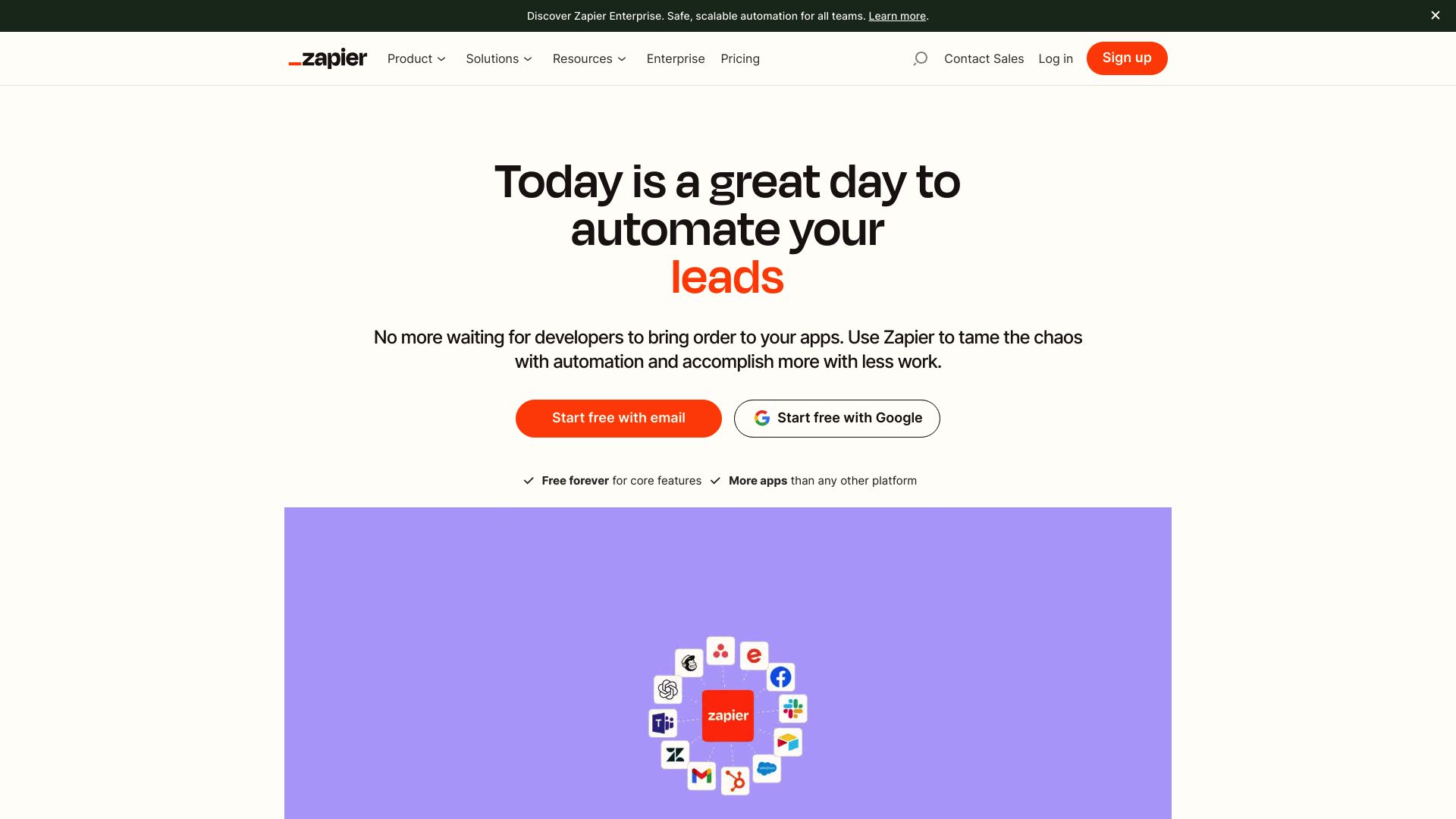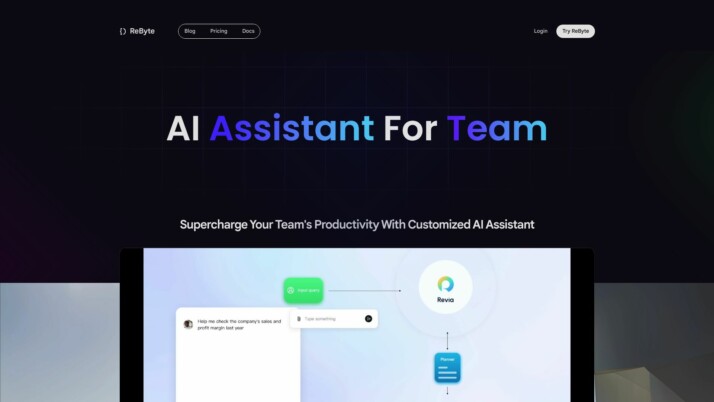Zapier vs. Rebyte: Comparing Automation and AI Development Tools
AI tools and automation platforms reshape how businesses operate, but choosing the right solution can be daunting. This comparison dives into Zapier, a widely-used automation platform, and Rebyte, an AI agent development tool, alongside SmythOS, our comprehensive AI automation solution. We’ll explore each platform’s strengths, limitations, and key features to help you make an informed decision.
Whether you’re a developer seeking powerful integrations, a business leader focused on scalability, or a non-technical user looking for accessible AI tools, this guide will illuminate the capabilities of these platforms and showcase how SmythOS combines the best of both worlds with additional advanced features.
Zapier Overview
Zapier empowers users to connect and automate workflows across thousands of apps without coding. The platform’s visual interface lets anyone create multi-step ’Zaps’ that trigger actions between different services.


Businesses leverage Zapier to streamline processes like lead management, data synchronization, and task automation. The platform shines in its vast app ecosystem, supporting over 6,000 integrations with popular services like Gmail, Slack, and Salesforce. This breadth of connections allows teams to build powerful workflows tailored to their specific needs.
Zapier empowers users to connect and automate workflows across thousands of apps without coding. The platform’s visual interface lets anyone create multi-step ’Zaps’ that trigger actions between different services.
Zapier’s no-code approach democratizes automation for non-technical users. The drag-and-drop Zap editor guides users through connecting triggers and actions visually. For developers, Zapier offers a CLI and API for building custom integrations. This flexibility caters to both citizen developers and programming experts.
While Zapier excels at connecting disparate apps, it lacks some advanced AI capabilities. The platform doesn’t offer features like natural language processing or autonomous agents. Instead, Zapier focuses on reliable, rules-based automation. This makes it ideal for straightforward task automation but may limit its use for more complex, AI-driven workflows.
Zapier’s strength lies in its ease of use, extensive integrations, and ability to quickly automate repetitive tasks. However, users seeking advanced AI functionality or deep customization may find the platform’s capabilities somewhat constrained compared to more specialized tools.
Rebyte Overview
Rebyte empowers users to rapidly develop AI-powered applications without extensive coding skills. The platform’s visual agent builder enables creation of customizable AI agents with complex backend logic using large language models. Users can design fully customized user interfaces for their agents without writing code.


Rebyte’s serverless runtime handles hosting, orchestration, testing, and deployment of AI agents. This streamlines the process from ideation to production, allowing knowledge workers and teams to automate workflows and boost productivity through no-code interfaces. The platform manages the entire lifecycle of AI applications with minimal manual coding required.
Rebyte’s serverless runtime handles hosting, orchestration, testing, and deployment of AI agents. This streamlines the process from ideation to production…
Key differentiators include Rebyte’s visual builder, integrated runtime, and focus on end-user AI application development. The platform offers integrations with private data sources and provides detailed observability into each step of an agent’s operations. This transparency enables users to monitor and refine their AI solutions effectively.
While Rebyte excels in democratizing AI development, it lacks some advanced features found in enterprise-grade solutions. The platform does not offer hosted vector databases, multimodal capabilities, or advanced security features like IP control. Additionally, deployment options are limited compared to more comprehensive AI development environments.
Rebyte’s vision centers on ushering in an era where anyone can rapidly transform ideas into deployed AI applications through natural language descriptions. This approach aims to lower barriers to AI adoption across industries, potentially accelerating innovation in AI-powered tools and workflows.
Feature Comparison
Zapier and Rebyte offer contrasting approaches to automation and AI development. Zapier excels in connecting diverse web applications through its extensive library of pre-built integrations, enabling users to create automated workflows without coding. However, it lacks advanced AI capabilities like natural language processing or autonomous agents. Rebyte, on the other hand, focuses on empowering users to build custom AI agents with complex logic using large language models.
A key difference lies in their core components. Zapier’s strength is its vast ecosystem of app integrations, allowing users to automate tasks across thousands of services. Rebyte provides a visual agent builder for creating AI-powered applications, emphasizing customization of user interfaces and backend logic. While Zapier offers a visual workflow editor, it doesn’t match Rebyte’s capabilities in AI agent development.
Regarding security, both platforms implement data encryption and OAuth authentication. However, neither offers advanced features like IP control or constrained alignment for AI behavior. Rebyte’s focus on AI applications may present additional security considerations related to data handling and model deployment that Zapier doesn’t encounter in its integration-focused approach.
Feature Comparison Table
| Zapier | Rebyte | SmythOS | |
|---|---|---|---|
| CORE FEATURES | |||
| AI Agents | ❌ | ✅ | ✅ |
| Hosted Agents (Dev, Production) | ❌ | ✅ | ✅ |
| Memory & Context | ❌ | ✅ | ✅ |
| Autonomous Agents | ❌ | ❌ | ✅ |
| Explainability & Transparency | ❌ | ✅ | ✅ |
| Multimodal | ❌ | ❌ | ✅ |
| Problem-Solving Capabilities | ❌ | ✅ | ✅ |
| Multi-Agent Collaboration | ❌ | ❌ | ✅ |
| Human-AI Interaction | ❌ | ✅ | ✅ |
| Agent Work Scheduler | ❌ | ✅ | ✅ |
| SECURITY | |||
| Constrained Alignment | ❌ | ❌ | ✅ |
| Data Encryption | ✅ | ❌ | ✅ |
| OAuth | ✅ | ❌ | ✅ |
| IP Control | ❌ | ❌ | ✅ |
| COMPONENTS | |||
| Foundation AIs | ❌ | ✅ | ✅ |
| Huggingface AIs | ❌ | ❌ | ✅ |
| Classifiers | ❌ | ❌ | ✅ |
| Logic | ❌ | ❌ | ✅ |
| Data Lakes | ❌ | ❌ | ✅ |
| DEPLOYMENT OPTIONS (EMBODIMENTS) | |||
| Deploy as Webhook | ✅ | ❌ | ✅ |
| Staging Domains | ✅ | ❌ | ✅ |
| Production Domains | ✅ | ❌ | ✅ |
| API Authentication (OAuth + Key) | ✅ | ❌ | ✅ |
| Deploy as Site Chat | ❌ | ✅ | ✅ |
| Deploy as Scheduled Agent | ❌ | ❌ | ✅ |
| Deploy as GPT | ❌ | ✅ | ✅ |
| DATA LAKE SUPPORT | |||
| Hosted Vector Database | ❌ | ✅ | ✅ |
| Sitemap Crawler | ❌ | ❌ | ✅ |
| YouTube Transcript Crawler | ❌ | ❌ | ✅ |
| URL Crawler | ❌ | ❌ | ✅ |
| PDF Support | ❌ | ✅ | ✅ |
| Word File Support | ❌ | ✅ | ✅ |
| TXT File Support | ❌ | ✅ | ✅ |
Best Alternative to Zapier and Rebyte
SmythOS stands out as the superior alternative to Zapier and Rebyte for AI agent development and automation. Our platform combines the best of both worlds, offering Zapier’s extensive integration capabilities and Rebyte’s AI agent creation, while surpassing both in terms of features, ease of use, and versatility.
We provide a comprehensive solution for businesses and developers seeking to harness the power of AI. Our drag-and-drop interface simplifies the creation of complex AI workflows, making advanced automation accessible to users of all skill levels. Unlike Zapier’s limited AI capabilities or Rebyte’s focus on visual agent building, SmythOS offers a full spectrum of AI tools, from foundation models to custom logic components.
SmythOS offers a full spectrum of AI tools, from foundation models to custom logic components.
Our platform excels in multi-agent collaboration, a feature absent in both Zapier and Rebyte. This allows for the creation of sophisticated AI ecosystems where multiple agents work together seamlessly. We also offer unparalleled deployment flexibility, enabling users to deploy their AI solutions as APIs, webhooks, chatbots, or scheduled tasks — options not fully available with our competitors.
Security and scalability set SmythOS apart. We implement robust data encryption, OAuth authentication, and IP control features, ensuring your AI agents operate in a secure environment. Our scalable architecture supports enterprise-level deployments, allowing your AI solutions to grow with your business needs.
With SmythOS, we’ve eliminated the limitations found in Zapier and Rebyte. Our platform offers a unified solution for AI agent development, automation, and deployment, empowering users to create truly intelligent, adaptable, and efficient AI systems. Choose SmythOS for a future-proof AI platform that delivers unmatched capabilities and ease of use.
Conclusion
Zapier and Rebyte offer distinct approaches to automation and AI development, each with its own strengths. Zapier excels in connecting diverse web applications, enabling users to create automated workflows without coding across thousands of services. Rebyte focuses on building custom AI agents with complex logic using large language models, emphasizing AI-powered application development.
While both platforms have their merits, SmythOS emerges as the superior choice for businesses seeking comprehensive AI automation solutions. We combine the best of both worlds — offering extensive integrations like Zapier and advanced AI capabilities like Rebyte, while providing additional features that set us apart.
Our drag-and-drop interface allows for intuitive agent creation, supporting both code-free development and advanced customization. Unlike Zapier’s limited AI capabilities or Rebyte’s focus on single-purpose agents, SmythOS enables the creation of sophisticated multi-agent systems that can collaborate on complex tasks. We also offer unparalleled deployment flexibility, allowing you to deploy SmythOS Agents Anywhere — from APIs and chatbots to scheduled tasks and GPT plugins.
For those ready to revolutionize their workflows with AI, we invite you to explore our diverse range of AI-powered agent templates and create a free SmythOS account to experience the future of AI automation firsthand. With our 30-day money-back guarantee and generous free tier, you can unlock the potential of AI for your business risk-free.
Last updated:
Disclaimer: The information presented in this article is for general informational purposes only and is provided as is. While we strive to keep the content up-to-date and accurate, we make no representations or warranties of any kind, express or implied, about the completeness, accuracy, reliability, suitability, or availability of the information contained in this article.
Any reliance you place on such information is strictly at your own risk. We reserve the right to make additions, deletions, or modifications to the contents of this article at any time without prior notice.
In no event will we be liable for any loss or damage including without limitation, indirect or consequential loss or damage, or any loss or damage whatsoever arising from loss of data, profits, or any other loss not specified herein arising out of, or in connection with, the use of this article.
Despite our best efforts, this article may contain oversights, errors, or omissions. If you notice any inaccuracies or have concerns about the content, please report them through our content feedback form. Your input helps us maintain the quality and reliability of our information.
